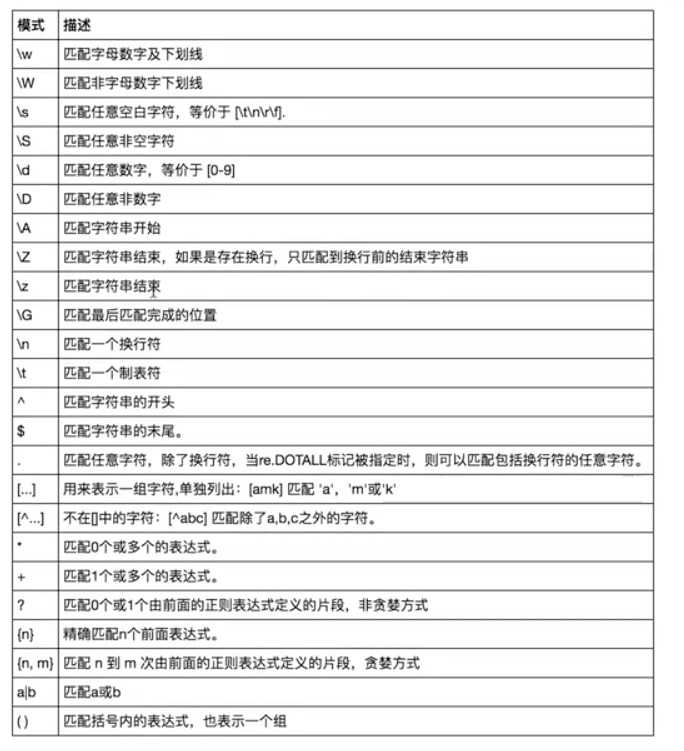标签:tps 模块 描述 分组 正则表达 gbk 输出 访问 [1]
什么是正则:
正则就是用一些具有特殊含义的符号组合到一起(称为正则表达式)来描述字符或者字符串的方法。或者说:正则就是用来描述一类事物的规则。(在Python中)它内嵌在Python中,并通过 re 模块实现。正则表达式模式被编译成一系列的字节码,然后由用 C 编写的匹配引擎执行。


# =================================匹配模式================================= #一对一的匹配 # ‘hello‘.replace(old,new) # ‘hello‘.find(‘pattern‘) #正则匹配 import re #\w与\W print(re.findall(‘\w‘,‘hello egon 123‘)) #[‘h‘, ‘e‘, ‘l‘, ‘l‘, ‘o‘, ‘e‘, ‘g‘, ‘o‘, ‘n‘, ‘1‘, ‘2‘, ‘3‘] print(re.findall(‘\W‘,‘hello egon 123‘)) #[‘ ‘, ‘ ‘] #\s与\S print(re.findall(‘\s‘,‘hello egon 123‘)) #[‘ ‘, ‘ ‘, ‘ ‘, ‘ ‘] print(re.findall(‘\S‘,‘hello egon 123‘)) #[‘h‘, ‘e‘, ‘l‘, ‘l‘, ‘o‘, ‘e‘, ‘g‘, ‘o‘, ‘n‘, ‘1‘, ‘2‘, ‘3‘] #\n \t都是空,都可以被\s匹配 print(re.findall(‘\s‘,‘hello \n egon \t 123‘)) #[‘ ‘, ‘\n‘, ‘ ‘, ‘ ‘, ‘\t‘, ‘ ‘] #\n与\t print(re.findall(r‘\n‘,‘hello egon \n123‘)) #[‘\n‘] print(re.findall(r‘\t‘,‘hello egon\t123‘)) #[‘\n‘] #\d与\D print(re.findall(‘\d‘,‘hello egon 123‘)) #[‘1‘, ‘2‘, ‘3‘] print(re.findall(‘\D‘,‘hello egon 123‘)) #[‘h‘, ‘e‘, ‘l‘, ‘l‘, ‘o‘, ‘ ‘, ‘e‘, ‘g‘, ‘o‘, ‘n‘, ‘ ‘] #\A与\Z print(re.findall(‘\Ahe‘,‘hello egon 123‘)) #[‘he‘],\A==>^ print(re.findall(‘123\Z‘,‘hello egon 123‘)) #[‘he‘],\Z==>$ #^与$ print(re.findall(‘^h‘,‘hello egon 123‘)) #[‘h‘] print(re.findall(‘3$‘,‘hello egon 123‘)) #[‘3‘] # 重复匹配:| . | * | ? | .* | .*? | + | {n,m} | #. print(re.findall(‘a.b‘,‘a1b‘)) #[‘a1b‘] print(re.findall(‘a.b‘,‘a1b a*b a b aaab‘)) #[‘a1b‘, ‘a*b‘, ‘a b‘, ‘aab‘] print(re.findall(‘a.b‘,‘a\nb‘)) #[] print(re.findall(‘a.b‘,‘a\nb‘,re.S)) #[‘a\nb‘] print(re.findall(‘a.b‘,‘a\nb‘,re.DOTALL)) #[‘a\nb‘]同上一条意思一样 #* print(re.findall(‘ab*‘,‘bbbbbbb‘)) #[] print(re.findall(‘ab*‘,‘a‘)) #[‘a‘] print(re.findall(‘ab*‘,‘abbbb‘)) #[‘abbbb‘] #? print(re.findall(‘ab?‘,‘a‘)) #[‘a‘] print(re.findall(‘ab?‘,‘abbb‘)) #[‘ab‘] #匹配所有包含小数在内的数字 print(re.findall(‘\d+\.?\d*‘,"asdfasdf123as1.13dfa12adsf1asdf3")) #[‘123‘, ‘1.13‘, ‘12‘, ‘1‘, ‘3‘] #.*默认为贪婪匹配 print(re.findall(‘a.*b‘,‘a1b22222222b‘)) #[‘a1b22222222b‘] #.*?为非贪婪匹配:推荐使用 print(re.findall(‘a.*?b‘,‘a1b22222222b‘)) #[‘a1b‘] #+ print(re.findall(‘ab+‘,‘a‘)) #[] print(re.findall(‘ab+‘,‘abbb‘)) #[‘abbb‘] #{n,m} print(re.findall(‘ab{2}‘,‘abbb‘)) #[‘abb‘] print(re.findall(‘ab{2,4}‘,‘abbb‘)) #[‘abb‘] print(re.findall(‘ab{1,}‘,‘abbb‘)) #‘ab{1,}‘ ===> ‘ab+‘ print(re.findall(‘ab{0,}‘,‘abbb‘)) #‘ab{0,}‘ ===> ‘ab*‘ #[] print(re.findall(‘a[1*-]b‘,‘a1b a*b a-b‘)) #[]内的都为普通字符了,且如果-没有被转意的话,应该放到[]的开头或结尾 print(re.findall(‘a[^1*-]b‘,‘a1b a*b a-b a=b‘)) #[]内的^代表的意思是取反,所以结果为[‘a=b‘] print(re.findall(‘a[0-9]b‘,‘a1b a*b a-b a=b‘)) #[]内的^代表的意思是取反,所以结果为[‘a=b‘] print(re.findall(‘a[a-z]b‘,‘a1b a*b a-b a=b aeb‘)) #[]内的^代表的意思是取反,所以结果为[‘a=b‘] print(re.findall(‘a[a-zA-Z]b‘,‘a1b a*b a-b a=b aeb aEb‘)) #[]内的^代表的意思是取反,所以结果为[‘a=b‘] #\# print(re.findall(‘a\\c‘,‘a\c‘)) #对于正则来说a\\c确实可以匹配到a\c,但是在python解释器读取a\\c时,会发生转义,然后交给re去执行,所以抛出异常 print(re.findall(r‘a\\c‘,‘a\c‘)) #r代表告诉解释器使用rawstring,即原生字符串,把我们正则内的所有符号都当普通字符处理,不要转义 print(re.findall(‘a\\\\c‘,‘a\c‘)) #同上面的意思一样,和上面的结果一样都是[‘a\\c‘] #():分组 print(re.findall(‘ab+‘,‘ababab123‘)) #[‘ab‘, ‘ab‘, ‘ab‘] print(re.findall(‘(ab)+123‘,‘ababab123‘)) #[‘ab‘],匹配到末尾的ab123中的ab print(re.findall(‘(?:ab)+123‘,‘ababab123‘)) #findall的结果不是匹配的全部内容,而是组内的内容,?:可以让结果为匹配的全部内容 print(re.findall(‘href="(.*?)"‘,‘<a href="http://www.baidu.com">点击</a>‘))#[‘http://www.baidu.com‘] print(re.findall(‘href="(?:.*?)"‘,‘<a href="http://www.baidu.com">点击</a>‘))#[‘href="http://www.baidu.com"‘] #| print(re.findall(‘compan(?:y|ies)‘,‘Too many companies have gone bankrupt, and the next one is my company‘))
re提供的方法介绍

# ===========================re模块提供的方法介绍=========================== import re #1 print(re.findall(‘e‘,‘alex make love‘) ) #[‘e‘, ‘e‘, ‘e‘],返回所有满足匹配条件的结果,放在列表里 #2 print(re.search(‘e‘,‘alex make love‘).group()) #e,只到找到第一个匹配然后返回一个包含匹配信息的对象,该对象可以通过调用group()方法得到匹配的字符串,如果字符串没有匹配,则返回None。 #3 print(re.match(‘e‘,‘alex make love‘)) #None,同search,不过在字符串开始处进行匹配,完全可以用search+^代替match #4 print(re.split(‘[ab]‘,‘abcd‘)) #[‘‘, ‘‘, ‘cd‘],先按‘a‘分割得到‘‘和‘bcd‘,再对‘‘和‘bcd‘分别按‘b‘分割 #5 print(‘===>‘,re.sub(‘a‘,‘A‘,‘alex make love‘)) #===> Alex mAke love,不指定n,默认替换所有 print(‘===>‘,re.sub(‘a‘,‘A‘,‘alex make love‘,1)) #===> Alex make love print(‘===>‘,re.sub(‘a‘,‘A‘,‘alex make love‘,2)) #===> Alex mAke love print(‘===>‘,re.sub(‘^(\w+)(.*?\s)(\w+)(.*?\s)(\w+)(.*?)$‘,r‘\5\2\3\4\1‘,‘alex make love‘)) #===> love make alex print(‘===>‘,re.subn(‘a‘,‘A‘,‘alex make love‘)) #===> (‘Alex mAke love‘, 2),结果带有总共替换的个数 #6 obj=re.compile(‘\d{2}‘) print(obj.search(‘abc123eeee‘).group()) #12 print(obj.findall(‘abc123eeee‘)) #[‘12‘],重用了obj import re print(re.findall("<(?P<tag_name>\w+)>\w+</(?P=tag_name)>","<h1>hello</h1>")) #[‘h1‘] print(re.search("<(?P<tag_name>\w+)>\w+</(?P=tag_name)>","<h1>hello</h1>").group()) #<h1>hello</h1> print(re.search("<(?P<tag_name>\w+)>\w+</(?P=tag_name)>","<h1>hello</h1>").groupdict()) #<h1>hello</h1> print(re.search(r"<(\w+)>\w+</(\w+)>","<h1>hello</h1>").group()) print(re.search(r"<(\w+)>\w+</\1>","<h1>hello</h1>").group())
补充

import re #使用|,先匹配的先生效,|左边是匹配小数,而findall最终结果是查看分组,所有即使匹配成功小数也不会存入结果 #而不是小数时,就去匹配(-?\d+),匹配到的自然就是,非小数的数,在此处即整数 # print(re.findall(r"-?\d+\.\d*|(-?\d+)","1-2*(60+(-40.35/5)-(-4*3))")) #找出所有整数[‘1‘, ‘-2‘, ‘60‘, ‘‘, ‘5‘, ‘-4‘, ‘3‘] #找到所有数字: print(re.findall(‘\D?(\-?\d+\.?\d*)‘,"1-2*(60+(-40.35/5)-(-4*3))")) # [‘1‘,‘2‘,‘60‘,‘-40.35‘,‘5‘,‘-4‘,‘3‘] #计算器作业参考:http://www.cnblogs.com/wupeiqi/articles/4949995.html expression=‘1-2*((60+2*(-3-40.0/5)*(9-2*5/3+7/3*99/4*2998+10*568/14))-(-4*3)/(16-3*2))‘ content=re.search(‘\(([\-\+\*\/]*\d+\.?\d*)+\)‘,expression).group() #(-3-40.0/5)
match:只检测re是不是在字符串开始的位置匹配,是的话返回对象,不是返回None
search:会浏览整个字符串查找匹配,匹配到一个就返回对象,没有就返回None

#为何同样的表达式search与findall却有不同结果: print(re.search(‘\(([\+\-\*\/]*\d+\.?\d*)+\)‘,"1-12*(60+(-40.35/5)-(-4*3))").group()) #(-40.35/5) print(re.findall(‘\(([\+\-\*\/]*\d+\.?\d*)+\)‘,"1-12*(60+(-40.35/5)-(-4*3))")) #[‘/5‘, ‘*3‘] #看这个例子:(\d)+相当于(\d)(\d)(\d)(\d)...,是一系列分组 print(re.search(‘(\d)+‘,‘123‘).group()) #group的作用是将所有组拼接到一起显示出来 print(re.findall(‘(\d)+‘,‘123‘)) #findall结果是组内的结果,且是最后一个组的结果

#_*_coding:utf-8_*_ __author__ = ‘Linhaifeng‘ #在线调试工具:tool.oschina.net/regex/# import re s=‘‘‘ http://www.baidu.com egon@oldboyedu.com 你好 010-3141 ‘‘‘ #最常规匹配 # content=‘Hello 123 456 World_This is a Regex Demo‘ # res=re.match(‘Hello\s\d\d\d\s\d{3}\s\w{10}.*Demo‘,content) # print(res) # print(res.group()) # print(res.span()) #泛匹配 # content=‘Hello 123 456 World_This is a Regex Demo‘ # res=re.match(‘^Hello.*Demo‘,content) # print(res.group()) #匹配目标,获得指定数据 # content=‘Hello 123 456 World_This is a Regex Demo‘ # res=re.match(‘^Hello\s(\d+)\s(\d+)\s.*Demo‘,content) # print(res.group()) #取所有匹配的内容 # print(res.group(1)) #取匹配的第一个括号内的内容 # print(res.group(2)) #去陪陪的第二个括号内的内容 #贪婪匹配:.*代表匹配尽可能多的字符 # import re # content=‘Hello 123 456 World_This is a Regex Demo‘ # # res=re.match(‘^He.*(\d+).*Demo$‘,content) # print(res.group(1)) #只打印6,因为.*会尽可能多的匹配,然后后面跟至少一个数字 #非贪婪匹配:?匹配尽可能少的字符 # import re # content=‘Hello 123 456 World_This is a Regex Demo‘ # # res=re.match(‘^He.*?(\d+).*Demo$‘,content) # print(res.group(1)) #只打印6,因为.*会尽可能多的匹配,然后后面跟至少一个数字 #匹配模式:.不能匹配换行符 content=‘‘‘Hello 123456 World_This is a Regex Demo ‘‘‘ # res=re.match(‘He.*?(\d+).*?Demo$‘,content) # print(res) #输出None # res=re.match(‘He.*?(\d+).*?Demo$‘,content,re.S) #re.S让.可以匹配换行符 # print(res) # print(res.group(1)) #转义:\ # content=‘price is $5.00‘ # res=re.match(‘price is $5.00‘,content) # print(res) # # res=re.match(‘price is \$5\.00‘,content) # print(res) #总结:尽量精简,详细的如下 # 尽量使用泛匹配模式.* # 尽量使用非贪婪模式:.*? # 使用括号得到匹配目标:用group(n)去取得结果 # 有换行符就用re.S:修改模式 #re.search:会扫描整个字符串,不会从头开始,找到第一个匹配的结果就会返回 # import re # content=‘Extra strings Hello 123 456 World_This is a Regex Demo Extra strings‘ # # res=re.match(‘Hello.*?(\d+).*?Demo‘,content) # print(res) #输出结果为None # # import re # content=‘Extra strings Hello 123 456 World_This is a Regex Demo Extra strings‘ # # res=re.search(‘Hello.*?(\d+).*?Demo‘,content) # # print(res.group(1)) #输出结果为 #re.search:只要一个结果,匹配演练, import re content=‘‘‘ <tbody> <tr id="4766303201494371851675" class="even "><td><div class="hd"><span class="num">1</span><div class="rk "><span class="u-icn u-icn-75"></span></div></div></td><td class="rank"><div class="f-cb"><div class="tt"><a href="/song?id=476630320"><img class="rpic" src="http://p1.music.126.net/Wl7T1LBRhZFg0O26nnR2iQ==/19217264230385030.jpg?param=50y50&quality=100"></a><span data-res-id="476630320" " # res=re.search(‘<a\shref=.*?<b\stitle="(.*?)".*?b>‘,content) # print(res.group(1)) #re.findall:找到符合条件的所有结果 # res=re.findall(‘<a\shref=.*?<b\stitle="(.*?)".*?b>‘,content) # for i in res: # print(i) #re.sub:字符串替换 import re content=‘Extra strings Hello 123 456 World_This is a Regex Demo Extra strings‘ # content=re.sub(‘\d+‘,‘‘,content) # print(content) #用\1取得第一个括号的内容 #用法:将123与456换位置 # import re # content=‘Extra strings Hello 123 456 World_This is a Regex Demo Extra strings‘ # # # content=re.sub(‘(Extra.*?)(\d+)(\s)(\d+)(.*?strings)‘,r‘\1\4\3\2\5‘,content) # content=re.sub(‘(\d+)(\s)(\d+)‘,r‘\3\2\1‘,content) # print(content) # import re # content=‘Extra strings Hello 123 456 World_This is a Regex Demo Extra strings‘ # # res=re.search(‘Extra.*?(\d+).*strings‘,content) # print(res.group(1)) # import requests,re # respone=requests.get(‘https://book.douban.com/‘).text # print(respone) # print(‘======‘*1000) # print(‘======‘*1000) # print(‘======‘*1000) # print(‘======‘*1000) # res=re.findall(‘<li.*?cover.*?href="(.*?)".*?title="(.*?)">.*?more-meta.*?author">(.*?)</span.*?year">(.*?)</span.*?publisher">(.*?)</span.*?</li>‘,respone,re.S) # # res=re.findall(‘<li.*?cover.*?href="(.*?)".*?more-meta.*?author">(.*?)</span.*?year">(.*?)</span.*?publisher">(.*?)</span>.*?</li>‘,respone,re.S) # # # for i in res: # print(‘%s %s %s %s‘ %(i[0].strip(),i[1].strip(),i[2].strip(),i[3].strip()))
subprocess模块
sub 子
process 进程
什么是进程
正在进行中的程序 每当打开一个程序就会开启一个进程
每个进程包含运行程序所需的所有资源
正常情况下 不可以跨进程访问数据
但是有些情况写就需要访问别的进程数据 提供一个叫做管道的对象 专门用于跨进程通讯
作用:用于执行系统命令
常用方法
run 返回一个表示执行结果的对象
call 返回的执行的状态码
总结 subprocess的好处是可以获取指令的执行结果
subprocess执行指令时 可以在子进程中 这样避免造成主进程卡死
import subprocess
# print(1)
# res = subprocess.run("tasklist",shell=True,stdout=subprocess.PIPE)
#
# print("=====================================================")
# print(res.stdout.decode("gbk"))
#
# print(res.stderr)
# res = subprocess.call("tasklist",shell=True)
# print(res)
# 第一个进程a读取tasklist的内容 将数据交给另一个进程b 进程b将数据写到文件中
res1 = subprocess.Popen("tasklist",stdout=subprocess.PIPE,shell=True,stderr=subprocess.PIPE)
# print("hello")
# print(res1.stdout.read().decode("gbk"))
# print(res1.stderr.read().decode("gbk"))
#
# res2 = subprocess.Popen("findstr cmd",stdout=subprocess.PIPE,shell=True,stderr=subprocess.PIPE,stdin=res1.stdout)
# print(res2.stdout.read().decode("gbk"))
res2 = subprocess.Popen("echo >a.txt", stdout=subprocess.PIPE, shell=True, stderr=subprocess.PIPE,stdin=res1.stdout)
print(res2.stdout.read().decode("gbk"))
res1=subprocess.Popen(r‘‘,shell=True,stdout=subprocess.PIPE)
res=subprocess.Popen(‘findstr test*‘,shell=True,stdin=res1.stdout,stdout=subprocess.PIPE)
print(res.stdout.read().decode(‘gbk‘))
标签:tps 模块 描述 分组 正则表达 gbk 输出 访问 [1]
原文地址:https://www.cnblogs.com/ouyang99-/p/10415220.html